Development and Validation for Quantitative Determination of Genotoxic Impurity in Gemfibrozil by Gas Chromatography with Mass Spectrometry
Abstract
1. Introduction
2. Materials and Methods
2.1. Materials and Reagents
2.2. Equipment
2.3. Chromatographic Conditions
2.4. Mass Spectrometer Conditions
2.5. Impurity Standard and Test Sample Solution Preparation
3. Results
3.1. Optimization of Mass Spectrometric Parameters
3.2. Optimization of Chromatographic Conditions
3.3. Method Validation
3.4. Specificity and System Suitability
3.5. Limit of Detection, Limit of Quantification, Precision for Limit of Quantification
3.6. Linearity
3.7. Method Precision
3.8. Intermediate Precision
3.9. Accuracy
3.10. Robustness
3.11. Standard and Spike Solution Stability
4. Discussion
5. Conclusions
Supplementary Materials
Author Contributions
Funding
Institutional Review Board Statement
Informed Consent Statement
Data Availability Statement
Acknowledgments
Conflicts of Interest
References
- Stauffer, F.; Vanhoorne, V.; Pilcer, G.; Chavez, P.; Rome, S.; Schubert, M.; Aerts, L.; De Beer, T. Raw material variability of an active pharmaceutical ingredient and its relevance for processability in secondary continuous pharmaceutical manufacturing. Eur. J. Pharm. Biopharm. 2018, 127, 92–103. [Google Scholar] [CrossRef] [PubMed]
- Sangshetti, J.N.; Deshpande, M.; Zaheer, Z.; Shinde, D.B.; Arote, R. Quality by design approach: Regulatory need. Arab. J. Chem. 2017, 10, S3412–S3425. [Google Scholar] [CrossRef]
- Bolt, H.M.; Foth, H.; Hengstler, J.G.; Degen, G.H. Carcinogenicity categorization of chemicals—New aspects to be considered in a European perspective. Toxicol. Lett. 2004, 151, 29–41. [Google Scholar] [CrossRef]
- Kondo, K.; Watanabe, A.; Iwanaga, Y.; Abe, I.; Tanaka, H.; Nagaoka, M.H.; Akiyama, H.; Maitani, T. Determination of genotoxic phenylhydrazine agaritine in mushrooms using liquid chromatography–electrospray ionization tandem mass spectrometry. Food Addit. Contam. 2006, 23, 1179–1186. [Google Scholar] [CrossRef]
- Leblanc, B.; Charuel, C.; Ku, W.; Ogilvie, R. Acceptability of low levels of genotoxic impurities in new drug substances. Int. J. Pharm. Med. 2004, 18, 215–220. [Google Scholar] [CrossRef]
- Froetschl, R. Presentation at the 2009 PhRMA API Workshop. New Burn, NC, USA, 2009; 18–21. [Google Scholar]
- Savale, S.K. Genotoxicity of drugs: Introduction, prediction and evaluation. Asian J. Biomater. Res. 2018, 4, 1–29. [Google Scholar]
- Liu, K.-T.; Chen, C.-H. Determination of impurities in pharmaceuticals: Why and how? In Quality Management and Quality Control-New Trends and Developments; IntechOpen: London, UK, 2019; pp. 1–17. [Google Scholar]
- Gosar, A.; Sayyed, H.; Shaikh, T. Genotoxic impurities and its risk assessment in drug compounds. Drug Des. Intellect Prop. Int. J. 2018, 2, 227–232. [Google Scholar]
- Committee, E.S. Scientific Opinion on genotoxicity testing strategies applicable to food and feed safety assessment. EFSA J. 2011, 9, 2379. [Google Scholar]
- Shah, S.U. Importance of Genotoxicity & S2A guidelines for genotoxicity testing for pharmaceuticals. IOSR J. Pharm. Biol. Sci. 2012, 1, 43–54. [Google Scholar]
- Honorato, J.; Masso, R.; Purroy, A. The Use of Gemfibrozil in the Treatment of Primary Hyperlipoproteinæmia. Preliminary Report. Proc. R. Soc. Med. 1976, 69, 78–79. [Google Scholar] [CrossRef]
- Todd, P.A.; Ward, A. Gemfibrozil. Drugs 1988, 36, 314–339. [Google Scholar] [CrossRef] [PubMed]
- Creger, P.L.; Neuklis, W.; Arbor, A. Aryloxypentane Compounds. U.S. Patent 3,707,566, 26 December 1972. [Google Scholar]
- Creger, P.; Moersch, G.; Neuklis, W. Structure/activity relationship of gemfibrozil (CI-719) and related compounds. Proc. R. Soc. Med. 1976, 69, 3–5. [Google Scholar] [CrossRef] [PubMed]
- Yang, Q.; Ren, T.; Yang, S.; Li, X.; Chi, Y.; Yang, Y.; Gu, J.; Hu, C. Synthesis and Pharmacokinetic Study of Three Gemfibrozil Salts: An Exploration of the Structure–Property Relationship. Cryst. Growth Des. 2016, 16, 6060–6068. [Google Scholar] [CrossRef]
- Rubins, H.B.; Robins, S.J.; Collins, D.; Fye, C.L.; Anderson, J.W.; Elam, M.B.; Faas, F.H.; Linares, E.; Schaefer, E.J.; Schectman, G. Gemfibrozil for the secondary prevention of coronary heart disease in men with low levels of high-density lipoprotein cholesterol. New Engl. J. Med. 1999, 341, 410–418. [Google Scholar] [CrossRef]
- ICH Guidelines, Q 3A(R); Impurities is New Drug Product. The Quality Guide Lines for Active Pharmaceutical Ingredients Related to Impurities According to the International Conference of Harmonization. 2022. Available online: http://www.ich.org (accessed on 1 January 2023).
- Madasu, S.B.; Vekariya, N.A.; Velladurai, H.; Islam, A.; Sanasi, P.D.; Korupolu, R.B. Improved Process for Preparation of Gemfibrozil, an Antihypolipidemic. Org. Process Res. Dev. 2013, 17, 963–966. [Google Scholar] [CrossRef]
- Hitesh, T.K.; Mahantesh, J.; Vikrant, M.P.; Somanath, N.S.; Pravin, M.N.; Ameya, M.T.; Sudhir, N. An Improved Process for the Preparation of a Key Intermediate of Gemfibrozil. WIPO (PCT) Patent Application No. WO2019069321A1, 11 April 2019. [Google Scholar]
- Nunna, R.; Jayanna, N.; Ramachandran, D. An Improved New Path to Synthesize Gemfibrozil. Asian J. Chem. 2015, 27, 925. [Google Scholar] [CrossRef]
- Friedland, S.N.; Leong, A.; Filion, K.B.; Genest, J.; Lega, I.C.; Mottillo, S.; Poirier, P.; Reoch, J.; Eisenberg, M.J. The cardiovascular effects of peroxisome proliferator-activated receptor agonists. Am. J. Med. 2012, 125, 126–133. [Google Scholar] [CrossRef] [PubMed]
- Zhao, M.; Shi, J.; Li, W.; Guan, C.; Sun, C.; Peng, Y.; Zheng, J. Metabolic activation of gemfibrozil mediated by cytochrome P450 enzymes and sulfotransferases. Chem. Res. Toxicol. 2022, 35, 1257–1266. [Google Scholar] [CrossRef]
- Boyd, M.R.; Grygiel, J.J.; Minchin, R.F. Metabolic activation as a basis for organ-selective toxicity. Clin. Exp. Pharmacol. Physiol. 1983, 10, 87–99. [Google Scholar] [CrossRef] [PubMed]
- Ogilvie, B.W.; Zhang, D.; Li, W.; Rodrigues, A.D.; Gipson, A.E.; Holsapple, J.; Toren, P.; Parkinson, A. Glucuronidation converts gemfibrozil to a potent, metabolism-dependent inhibitor of CYP2C8: Implications for drug-drug interactions. Drug Metab. Dispos. 2006, 34, 191–197. [Google Scholar] [CrossRef]
- Sallustio, B.C.; Foster, D. Reactivity of gemfibrozil 1-o-beta-acyl glucuronide. Pharmacokinetics of covalently bound gemfibrozil-protein adducts in rats. Drug Metab. Dispos. 1995, 23, 892–899. [Google Scholar]
- U.S. Department of Health and Human Services. Registry of Toxic Effects of Chemical Substances (RTECS, Online Database); National Toxicology Information Program, National Library of Medicine: Bethesda, MD, USA, 1993. [Google Scholar]
- Omura, M.; Itonaga, Y.; Komatsu, H.; Mangen, Z.; Hirata, M.; Tanaka, A.; Inoue, N. The acute toxicity of allyl chloride by subcutaneous injection in mice. Fukuoka Igaku Zasshi = Hukuoka Acta Med. 1993, 84, 427–432. [Google Scholar] [PubMed]
- U.S. Environmental Protection Agency. Health and Environmental Effects Profile for Allyl Chloride; Environmental Criteria and Assessment Office, Office of Health and Environmental Assessment, Office of Research and Development: Cincinnati, OH, USA, 1986. [Google Scholar]
- Ingle, S.U.; Patil, P.P.; Barhate, S.D.; Umarkar, A.R. Stability indicating rp–hplc method for determination of gemfibrozil in pharmaceutical formulation. World J. Pharm. Res. 2015, 4, 1625–1635. [Google Scholar]
- Vishnupriya, S.; Narenderan, S.; Vishnu, K.; Babu, B.; Meyyanathan, S. A novel analytical liquid chromatography-tandem mass spectrometry method for the estimation of Gemfibrozil in bulk and pharmaceutical formulations. J. Appl. Pharm. Sci. 2019, 9, 97–101. [Google Scholar]
- Ulu, S.T. LC determination of gemfibrozil in tablets. Chromatographia 2006, 64, 447–451. [Google Scholar] [CrossRef]
- Branch, S.K. Guidelines from the international conference on harmonisation (ICH). J. Pharm. Biomed. Anal. 2005, 38, 798–805. [Google Scholar] [CrossRef] [PubMed]
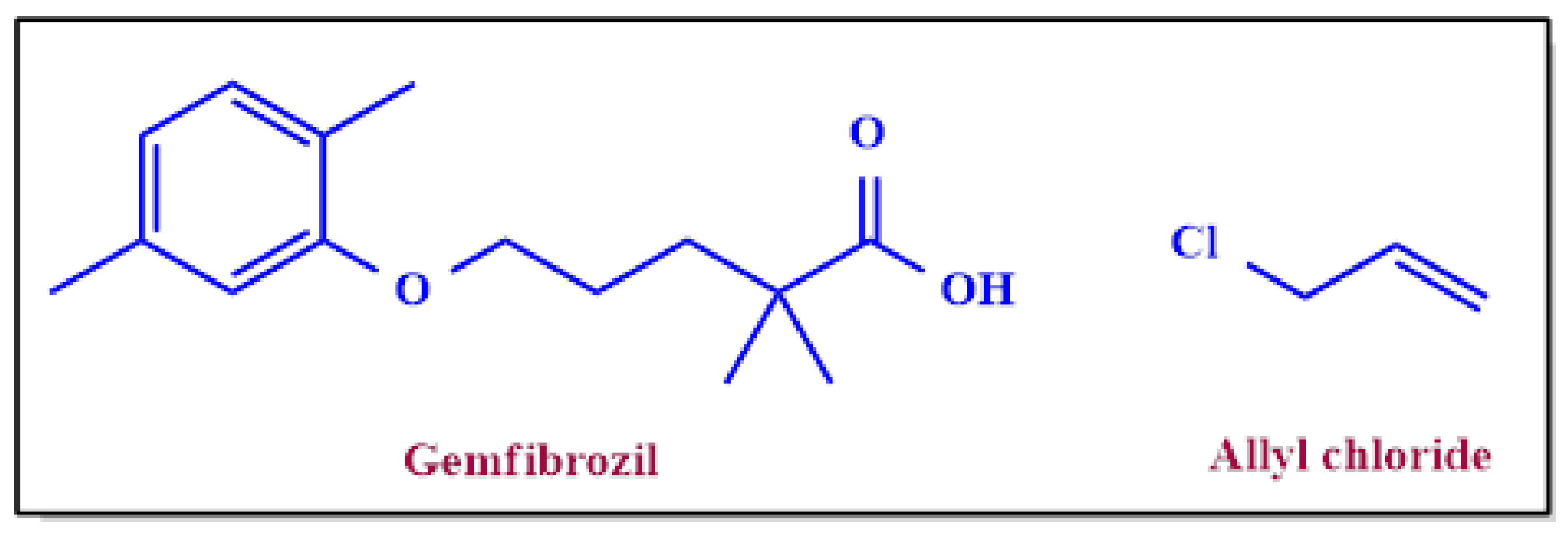
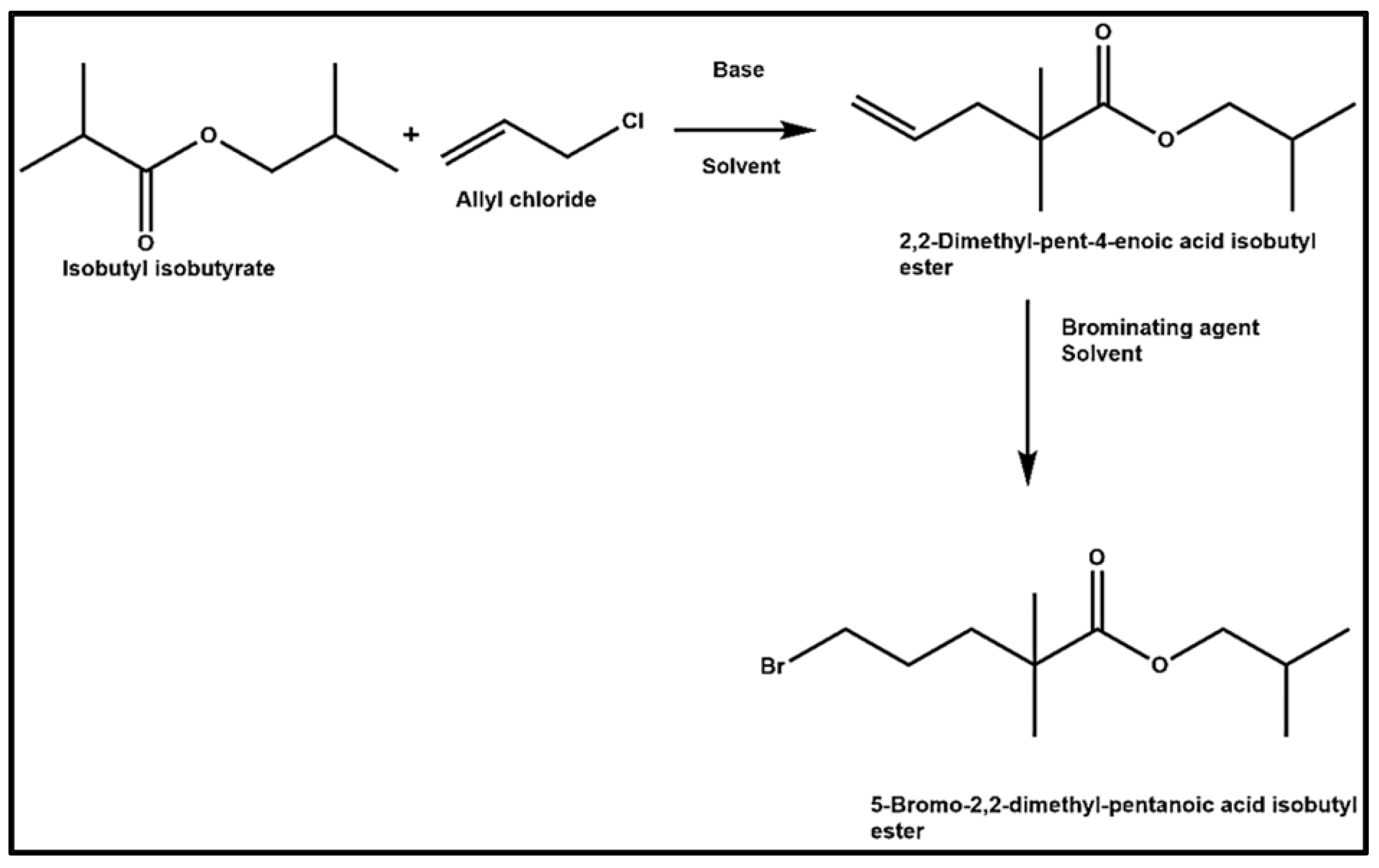

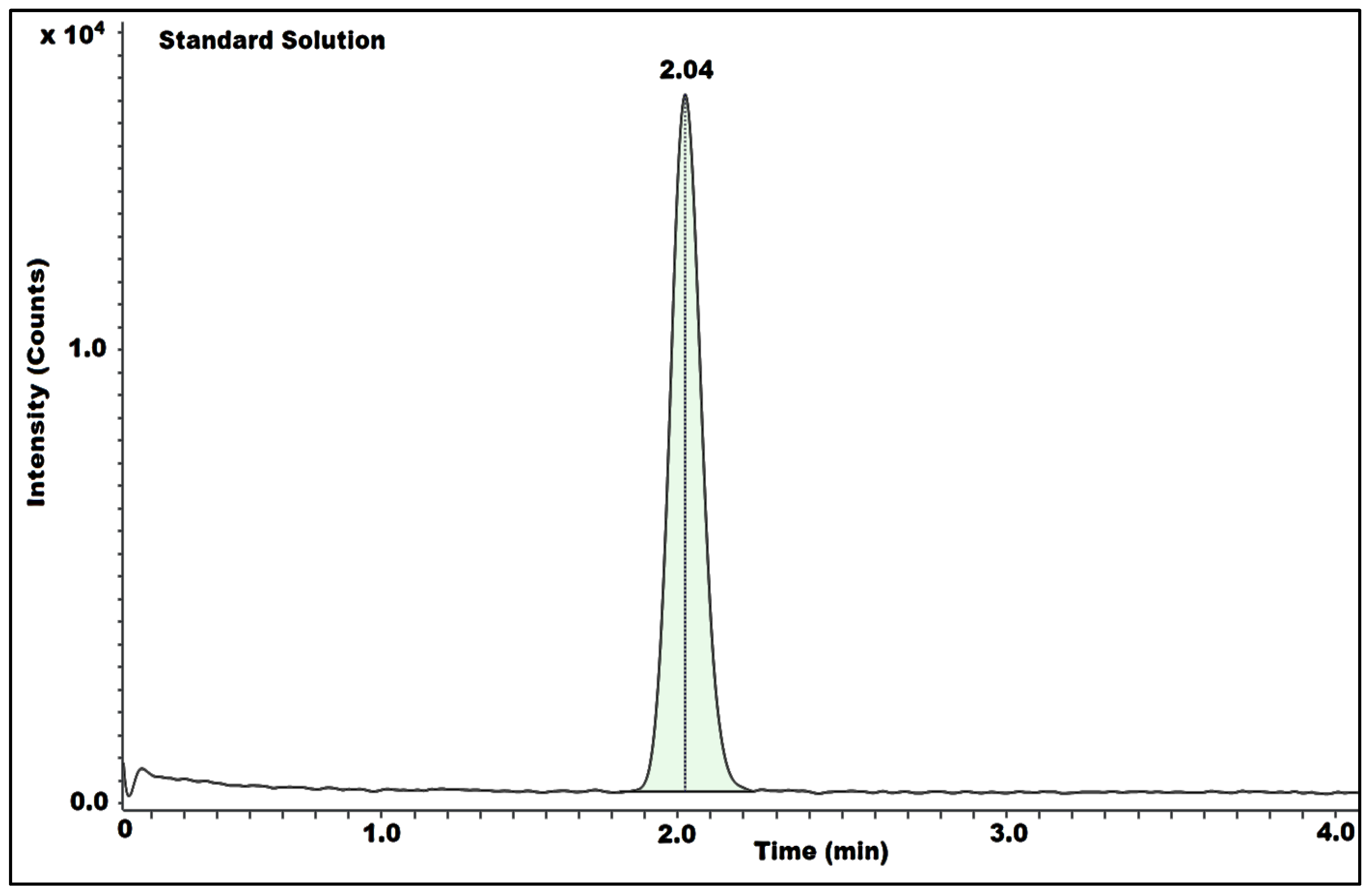
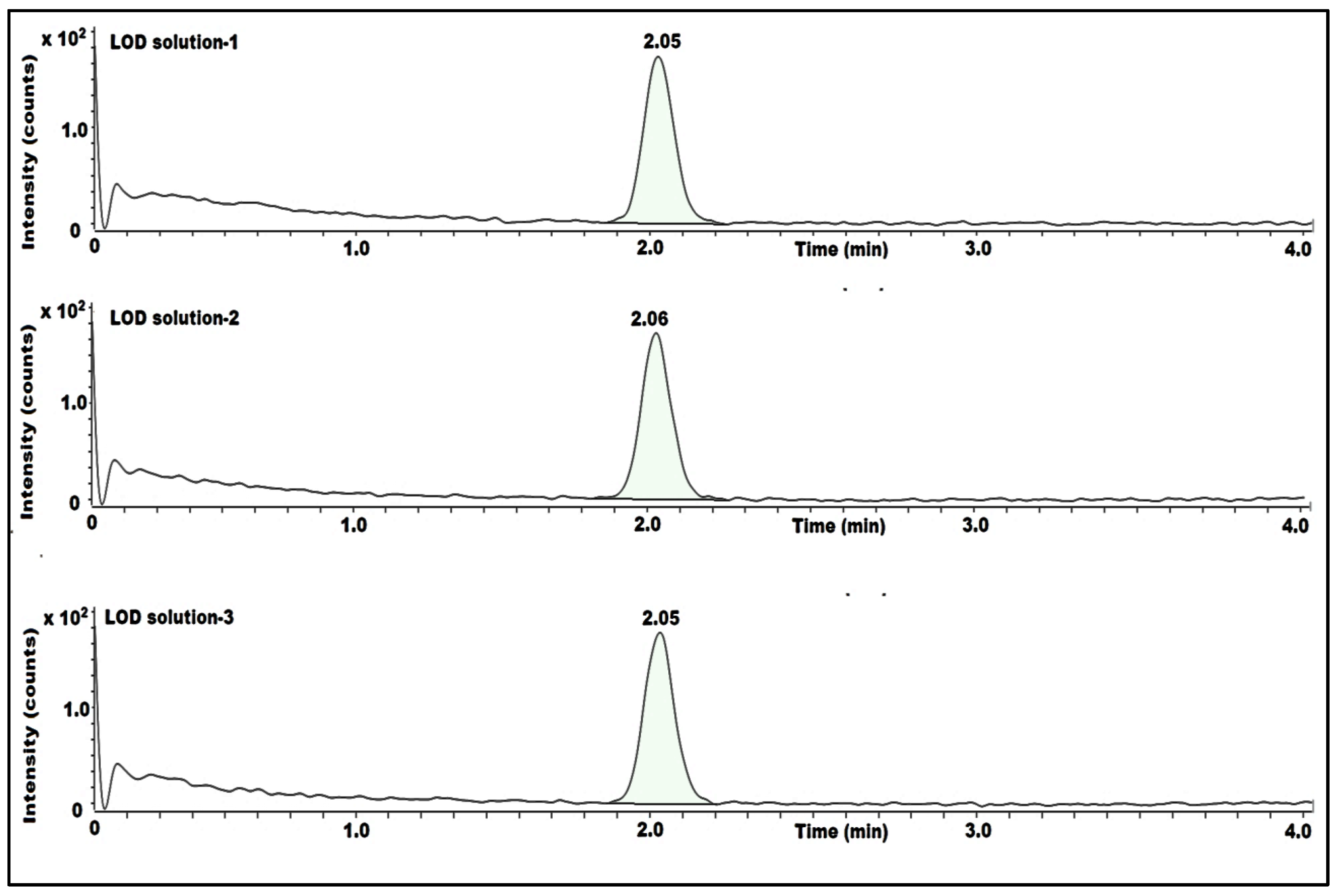
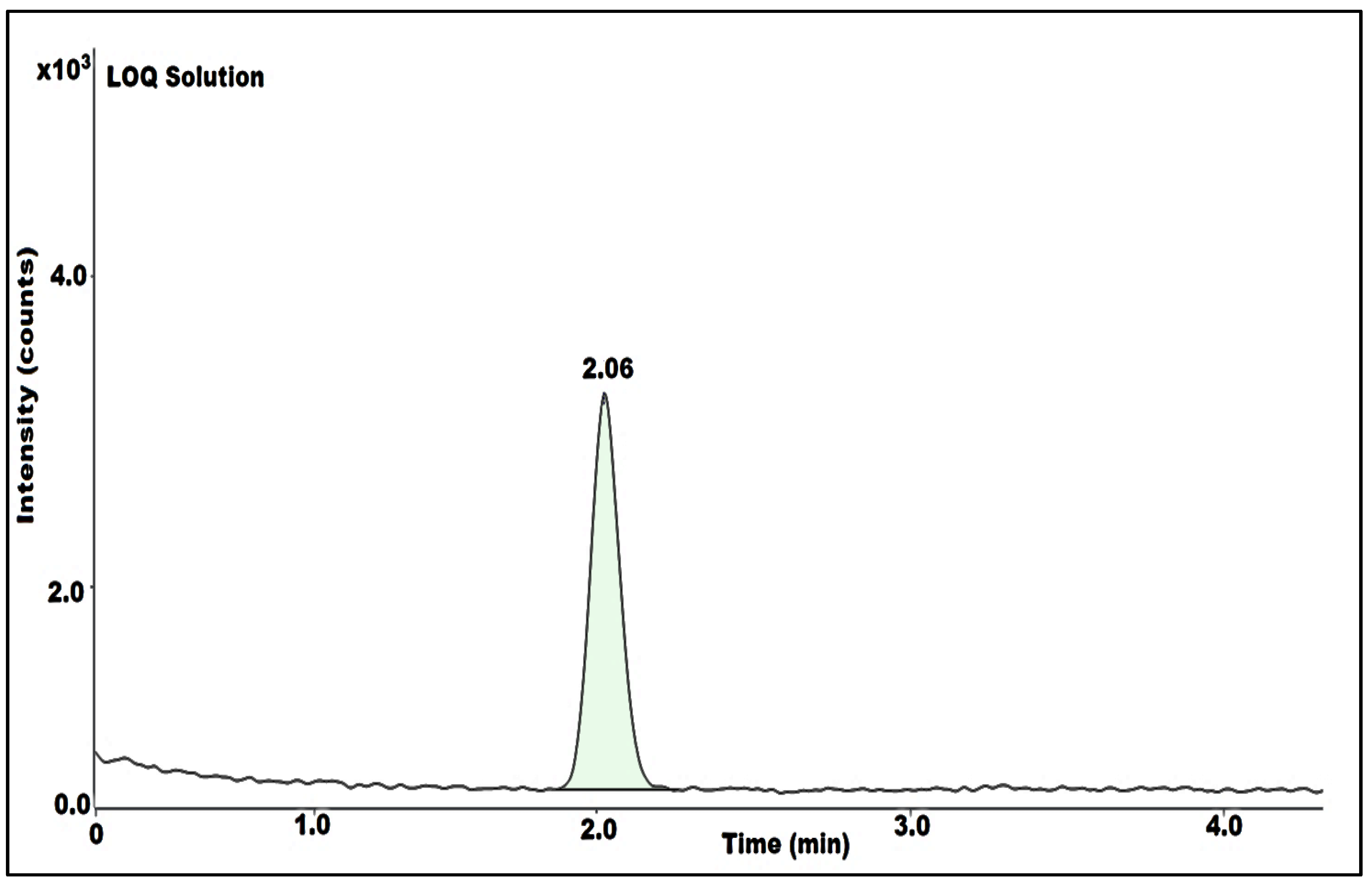

| Instrument Setup | Details | ||
|---|---|---|---|
| GC Parameters | |||
| Chromatographic system | Agilent Technologies 7890B GC system | ||
| GC Column | USP phase G27, 30 m length, 0.32 mm internal diameters, 1.5 µm film thickness | ||
| Carrier Gas | Helium | ||
| Column Mode | Constant Flow | ||
| Gas flow | 2 mL/min | ||
| Injector (Heater) | 200 °C | ||
| Volume of injection | 2 microliters | ||
| Oven Programming | Ramping (°C/min) rate | Temperature | Hold time in minutes |
| - | 40 (°C) | 0 | |
| 15 | 250 (°C) | 6 | |
| Split flow | 20 | ||
| Run time | 20 min | ||
| Mass spectrometry conditions | |||
| MS system | Agilent Technologies 7010B GC/TQ | ||
| Ion source and Detection mode | EI and MRM | ||
| For qualification (m/z) | 76 amu → 39 amu | ||
| For quantification (m/z) | 76 amu → 41 amu | ||
| Dwell time (in milliseconds) | 100 | ||
| Collision energy (CE) | 8 v | ||
| Gain Factor | 20 | ||
| Detector off (MS -Off) | 4 min | ||
| Temperature of Source (°C) | 230 | ||
| Temperature Transfer Line (°C) | 240 | ||
| MS Quad temperature (°C) | 150 | ||
| Parameters | Acceptance Criteria | Observation |
|---|---|---|
| Specificity and SST | Area % RSD of allyl chloride peak should be ≤15.0. | 3.5% |
| RT % RSD of allyl chloride peak should be ≤5.0. | 0.8% | |
| RT of allyl chloride peak. | 2 min | |
| Any blank Interference | Not observed | |
| Limit of detection | Limit of detection Concentration | 0.005 ppm |
| Signal-to-noise ratio should be ≥3 | 22 | |
| Limit of quantification | Limit of quantification Concentration | 0.01 ppm |
| Signal-to-noise ratio should be ≥10 | 45 | |
| Precision for Limit of quantification | Area % RSD of allyl chloride peak from 6 injections of LOQ solution should be ≤20.0% | 4.8% |
| Linearity and Range | Range for allyl chloride | 0.01 to 0.045 ppm |
| Correlation coefficient for allyl chloride linearity solutions should be ≥0.99 | 0.99 | |
| Square of the correlation coefficient for allyl chloride linearity solutions should be ≥0.99 | 0.99 |
| Parameters | Acceptance Criteria | Observation |
|---|---|---|
| Method precision | Area % RSD of allyl chloride peak from six preparations of spiked samples should be ≤15.0. | 5.5% |
| Intermediate precision | Area % RSD of allyl chloride peak from six preparations of spiked samples should be ≤15.0. | 4.8% |
| Area % RSD of allyl chloride peak from 12 preparations of spiked samples from MP and IP should be ≤20.0. | Results with in acceptance limit. | |
| Accuracy | The average recovery should be between 70% to 130% for LOQ spiked solution. | 94.40% |
| Average recovery should be between 80% to 120% for 50% spiked solution. | 96.60% | |
| Average recovery should be between 80% to 120% for 100% spiked solution. | 98.50% | |
| Average recovery should be between 80% to 120% for 150% spiked solution. | 97.30% | |
| Robustness | Plus flow: concentration difference and retention time of allyl chloride spiked sample. | 2.1%, 1.9 min |
| Minus flow: concentration difference and retention time of allyl chloride spiked sample. | 1.4%, 2.1 min | |
| Plus oven temperature: concentration difference and retention time of allyl chloride spiked sample. | 2.6%, 1.9 min | |
| Minus oven temperature: concentration difference and retention time of allyl chloride spiked sample. | 1.7%, 2.1 min | |
| Standard and spike solution Stability | Allyl chloride standard and spiked solutions were observed for 48 h under ambient laboratory temperature (25 ± 5 °C) and under refrigeration (2–8 °C). | Both solutions are Stable |
Disclaimer/Publisher’s Note: The statements, opinions and data contained in all publications are solely those of the individual author(s) and contributor(s) and not of MDPI and/or the editor(s). MDPI and/or the editor(s) disclaim responsibility for any injury to people or property resulting from any ideas, methods, instructions or products referred to in the content. |
© 2023 by the authors. Licensee MDPI, Basel, Switzerland. This article is an open access article distributed under the terms and conditions of the Creative Commons Attribution (CC BY) license (https://creativecommons.org/licenses/by/4.0/).
Share and Cite
Chittireddy, H.N.P.R.; Kumar, J.V.S.; Bhimireddy, A.; Shaik, M.R.; Hatshan, M.R.; Khan, M.; Alwarthan, A.; Shaik, B. Development and Validation for Quantitative Determination of Genotoxic Impurity in Gemfibrozil by Gas Chromatography with Mass Spectrometry. Separations 2023, 10, 145. https://doi.org/10.3390/separations10030145
Chittireddy HNPR, Kumar JVS, Bhimireddy A, Shaik MR, Hatshan MR, Khan M, Alwarthan A, Shaik B. Development and Validation for Quantitative Determination of Genotoxic Impurity in Gemfibrozil by Gas Chromatography with Mass Spectrometry. Separations. 2023; 10(3):145. https://doi.org/10.3390/separations10030145
Chicago/Turabian StyleChittireddy, Hari Naga Prasada Reddy, J. V. Shanmukha Kumar, Anuradha Bhimireddy, Mohammed Rafi Shaik, Mohammad Rafe Hatshan, Mujeeb Khan, Abdulrahman Alwarthan, and Baji Shaik. 2023. "Development and Validation for Quantitative Determination of Genotoxic Impurity in Gemfibrozil by Gas Chromatography with Mass Spectrometry" Separations 10, no. 3: 145. https://doi.org/10.3390/separations10030145
APA StyleChittireddy, H. N. P. R., Kumar, J. V. S., Bhimireddy, A., Shaik, M. R., Hatshan, M. R., Khan, M., Alwarthan, A., & Shaik, B. (2023). Development and Validation for Quantitative Determination of Genotoxic Impurity in Gemfibrozil by Gas Chromatography with Mass Spectrometry. Separations, 10(3), 145. https://doi.org/10.3390/separations10030145









